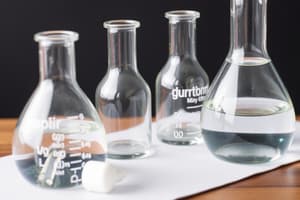Podcast
Questions and Answers
What is the state of oils at room temperature?
What is the state of oils at room temperature?
- Solid
- Gas
- Liquid (correct)
- Crystalline
Which property is not associated with pure oils?
Which property is not associated with pure oils?
- Greasy feel
- Odorless
- Tasteless
- Solid state (correct)
Which of the following statements about lipids is true?
Which of the following statements about lipids is true?
- They are esters of short chain fatty acids.
- They are found only in plants.
- They are present in all living organisms. (correct)
- They are only soluble in polar solvents.
In which solvents are lipids highly soluble?
In which solvents are lipids highly soluble?
What kind of odor is associated with the formation of acrolein?
What kind of odor is associated with the formation of acrolein?
What makes lipids a structural source of energy?
What makes lipids a structural source of energy?
Which of the following is a characteristic of fats, but not oils?
Which of the following is a characteristic of fats, but not oils?
Which chemical is a dehydrating agent mentioned in the content?
Which chemical is a dehydrating agent mentioned in the content?
What is the primary color characteristic of pure lipids?
What is the primary color characteristic of pure lipids?
Which of the following processes does NOT involve emulsification of fats?
Which of the following processes does NOT involve emulsification of fats?
What is the role of albumin as mentioned in the text?
What is the role of albumin as mentioned in the text?
Which statement about lipids' solubility is false?
Which statement about lipids' solubility is false?
Which of these reactions involves margarine and an acid?
Which of these reactions involves margarine and an acid?
Which taste characteristic applies to pure lipids?
Which taste characteristic applies to pure lipids?
What is a common consequence of the rancidification of fats/oils?
What is a common consequence of the rancidification of fats/oils?
What is the main reason lipids are categorized as non-polar compounds?
What is the main reason lipids are categorized as non-polar compounds?
Which pair of substances can lead to acrolein formation when combined with fats?
Which pair of substances can lead to acrolein formation when combined with fats?
What type of reaction occurs when alcohol is combined with coconut oil?
What type of reaction occurs when alcohol is combined with coconut oil?
Which components are involved in the production of DCM + coconut oil?
Which components are involved in the production of DCM + coconut oil?
Which of the following is a characteristic of the effects of fats/oils?
Which of the following is a characteristic of the effects of fats/oils?
What is the primary purpose of the iodine number in the context of fats and oils?
What is the primary purpose of the iodine number in the context of fats and oils?
Which test would yield a bluish-red to purple color when testing for cholesterol?
Which test would yield a bluish-red to purple color when testing for cholesterol?
What type of emulsion is produced when coconut oil is combined with Na2CO3 and water?
What type of emulsion is produced when coconut oil is combined with Na2CO3 and water?
What is the outcome of the glycerol test via acid dehydration?
What is the outcome of the glycerol test via acid dehydration?
Which statement is true about the halogenation reaction in testing oils?
Which statement is true about the halogenation reaction in testing oils?
How is the iodine value expressed in relation to fats and oils?
How is the iodine value expressed in relation to fats and oils?
What is the final product when rancid oil is mixed with Na2CO3 and water?
What is the final product when rancid oil is mixed with Na2CO3 and water?
What color shift indicates a positive result for the Liebermann Burchard test?
What color shift indicates a positive result for the Liebermann Burchard test?
Which factor affects the absorption characteristics of iodine in unsaturated fatty acids?
Which factor affects the absorption characteristics of iodine in unsaturated fatty acids?
Which emulsion is described as 'permanent' in the given experiments?
Which emulsion is described as 'permanent' in the given experiments?
Flashcards are hidden until you start studying
Study Notes
Physical Properties of Oils and Fats
- Oils are liquids at room temperature, while fats are solid.
- Both oils and fats have a greasy feel and are colorless, odorless, and tasteless in their pure forms.
Definition and Composition of Lipids
- Lipids are esters formed from long-chain fatty acids and alcohols.
- They are waxy or oily substances found in all living organisms.
- Lipids are non-polar and insoluble in polar solvents like water but soluble in non-polar solvents like ether, chloroform, benzene, and acetone.
Solubility of Lipids
- Lipids do not dissolve in water but dissolve well in organic solvents, collectively known as "lipid-solvents" or "fat-solvents."
Rancidification
- Rancidification involves the formation of acrolein (propenal), which has an acrid odor.
- Dehydrating agents like KHSO4 (potassium bisulfate) and MgSO4 can promote this process.
Emulsification of Fats
- Albumin can act as an emulsifier, stabilizing mixtures of oil and water.
- Temporary emulsions form when coconut oil mixes with water directly or with sodium carbonate.
- A stable emulsion can occur when rancid oil is mixed with water and albumin.
Halogenation Reactions
- Halogenation involves reactions with bromine and iodine, potentially used for testing the presence of unsaturation in fats and oils.
Tests for Cholesterol
- Salkowski's test shows a color change from bluish-red to purple.
- Liebermann-Burchard test uses acetic anhydride and sulfuric acid, resulting in a color change from red or pink to bluish-green to indicate cholesterol presence.
Test for Glycerol
- Glycerol can be converted to acrolein through acid dehydration.
Iodine Number (Value)
- The iodine number measures unsaturation in fats and oils, indicating the grams of iodine that react with 100 grams of fat.
- Unsaturated fatty acids absorb iodine at double bonds until fully saturated, providing insight into the degree of unsaturation in a sample.
Studying That Suits You
Use AI to generate personalized quizzes and flashcards to suit your learning preferences.




